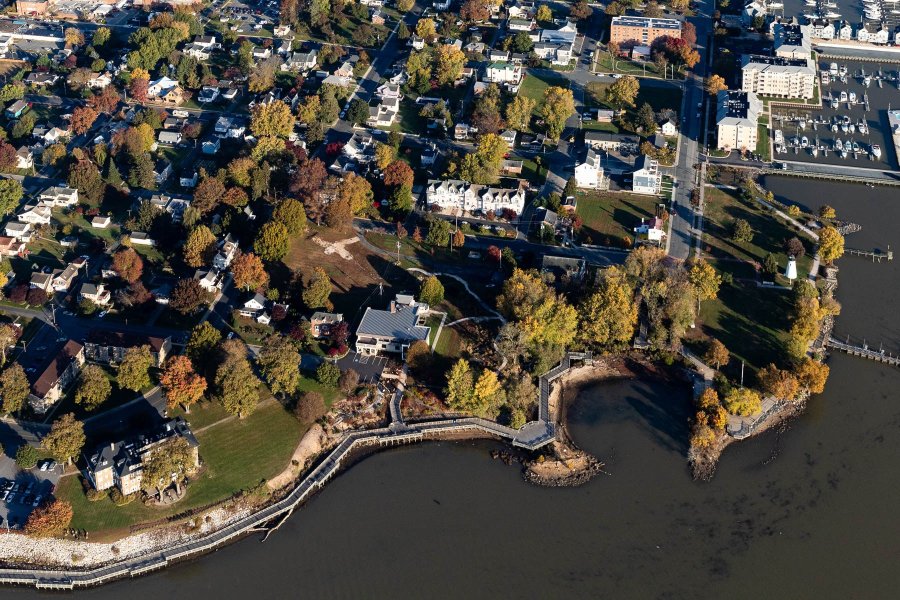The Duck Decoy capital of the world embraces green infrastructure
Havre de Grace answers stormwater issues with waterfront ecosystems

Much of what makes Havre de Grace, Maryland so special—and such a quintessential Chesapeake city—is packed into its public promenade at Concord Point. Here, you’ll find the city’s Maritime Museum, Duck Decoy Museum, Concord Point Lighthouse, historic Bayou Hotel and a sprawling view of the Susquehanna River flowing into the Chesapeake Bay.
Now, the park boasts a significant upgrade to the land surrounding the promenade, including a restored shoreline and two vegetated channels that double as Chesapeake Bay restoration projects.
Concord Point is a bustling part of Havre de Grace with shops, restaurants and rows of houses. But along with all that development comes significant levels of stormwater runoff. Prior to 2019, nearly 25 acres of stormwater rushed into two storm drains that discharged into the river, carrying nutrient pollution, chemical contaminants and dirt from the surrounding area. This runoff was keeping the city from meeting its Municipal Separate Stormwater Sewer System (MS4) permit, a federal requirement within the Clean Water Act.
“It’s always a high bar that they set for us with our MS4 credits,” said Mayor Bill Martin, who has led the city for over nine years.
To get their runoff issue under control, the city’s engineer came up with a project for revamping the area around the promenade. Instead of just taking on stormwater, the city saw this as an opportunity to upgrade their shoreline which had become a swampy area filled with concrete debris and litter.
“The driving factor behind it was to treat stormwater, and at the same time make our shoreline more inviting, attractive and a better habitat for marine life,” said Mayor Martin.

The city partnered with engineering firm Underwood & Associates, who had similar ideas for the project. With a slew of shoreline and stormwater projects completed across the Bay, Underwood & Associates has become known for designing human-centered landscapes. “We told the city, we don’t just want to do stormwater here. We want to build [a] park for you while we do your stormwater,” said Chris Becraft, a partner at Underwood & Associates.
Upland from the beach, Underwood & Associates constructed two stormwater filtration systems that, to the untrained eye, look like a lush channel of diverse shrubs, vegetation and boulders that fill up with water during a rainstorm. These systems are designed in such a way that during a storm the runoff slowly moves downward as the nutrient and sediment pollution is filtered out by the vegetation, and the water is cooled.
One of the stormwater filtration systems begins behind the Duck Decoy Museum and weaves its way down to the river, treating nearly 20 acres of stormwater. The other starts slightly closer to the waterfront and treats five acres of runoff. Before the systems were installed, a storm could wash runoff into the river within seconds. Now, according to Becraft, “the water barely ever gets to the river.”
Though constructed to manage stormwater, the systems fit seamlessly into the park. For the larger channel, Underwood & Associates created a walking trail running parallel to where the water fills in, and a small bridge for when the channel deepens. Visit the site on a nice day and you’re likely to see plenty of people taking the trail and enjoying the scenery, unaware of the true value of the site.
“You actually have to tell people, this is not just a trail, this is something that is designed to treat the runoff,” said Mayor Martin.

The other phase of the Concord Point project, and arguably its most exciting, was the installation of a new 1,363-foot shoreline. Being connected to the stormwater features constructed behind it, the beach helps to treat the runoff, almost as a last layer of defense before the river. But more importantly, the new shoreline protects Concord Point against a threat as serious as stormwater: flooding.
Sea level rise has brought higher tides to Havre de Grace, as it has across much of the Chesapeake Bay, flooding properties like the Duck Decoy Museum and eroding the waterfront. To overcome this, Underwood & Associates designed the shoreline so that it could repel and slow down waves and then absorb them as they reached the beach.
“Now, they don't have nearly the flooding that they had before,” said Becraft.
Just like with the stormwater systems, the natural shoreline has become another public-friendly part of the waterfront. Community members and visitors can be found strolling along the beach and launching a kayak on warm days. The shoreline also adds tidal habitat that was missing before, benefiting reptiles, fish and the city’s famous waterfowl.
“For a while we didn’t have many ducks in the area,” said Mayor Martin, “now all the ducks have come back.”

As with most environmental projects, the development of the shoreline came with some challenges. An oval patch of beach that extends out into the water was initially supposed to be filled with grasses and vegetation, but Underwood & Associates had trouble getting grasses to grow in, in part because the beach is in a tidal area with plenty of intrusion from the river.
“I would never not try and have this fully vegetated,” said Becraft, speaking on the extended surface of the shoreline. “[But] in pursuit of a natural shoreline at tidewater, I think we have to be okay with certain areas not being vegetated.”
All phases of the Concord Point project were funded through Maryland’s Chesapeake and Atlantic Coastal Bays Trust Fund, which focuses on efficient, cost-effective solutions to pollution in the Bay watershed.

Comments
There are no comments.
Thank you!
Your comment has been received. Before it can be published, the comment will be reviewed by our team to ensure it adheres with our rules of engagement.
Back to recent stories